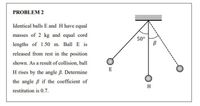Question

Transcribed Image Text:PROBLEM 2
Identical balls E and H have equal
masses of 2 kg and equal cord
50°
lengths of 1.50 m. Ball E is
released from rest in the position
shown. As a result of collision, ball
E
H rises by the angle B. Determine
the angle B if the coefficient of
H
restitution is 0.7.
Expert Solution
This question has been solved!
Explore an expertly crafted, step-by-step solution for a thorough understanding of key concepts.
Step by stepSolved in 6 steps with 1 images

Knowledge Booster
Similar questions
- Choose True if the information found on the statement is CORRECT and false if it is INCORRECT. True False The center of mass can be represented by a pair of coordinates. The units of Impulse (N s) and Momentum (kg m/s) the same. Center of mass and the centroid of an object are always in the same place. We can locate the center of mass of a system even though it is constantly changing. It is possible to have perfectly elastic collision. Prolonging the time of contact between two objects increases the force of impact. You can change an object's momentum without changing its mass or velocity The coefficient of restitution be negative. When the coefficient of restitution is equals 0, it means that the objects stick together after collision. Elastic collision means that there is a noticeable loss of kinetic energy before and after the collision.arrow_forwardPlease solve with detailed explanation. Thank youarrow_forwardAnswer part garrow_forward
- As shown in the figure below, two blocks (m1 and m2) are each released from rest at a height of h = 3.53 m on a frictionless track and when they meet on the horizontal section of the track they undergo an elastic collision. If m1 = 2.50 kg and m2 = 4.15 kg,determine the maximum heights (in m) to which they rise after the collision. Use the coordinate system shown in the figure.arrow_forwardⒸ Macmillan Learning Two particles approach each other with equal and opposite speed, v. The mass of one particle is m, and the mass of the other particle is nm, where n is just a constant factor. Snapshots of the system before, during, and after the elastic collision are shown. m V Before V What is the value of n? nm Collision V m,final m n = After the collision, the first particle moves in the exact opposite direction with speed 2.40v, and the speed of the second particle, Unm, final, is unknown. 68 After Incorrect nm nm,finalarrow_forwardA time-varying horizontal force of F(t) = ßt3 acts on an object for 1.46 seconds, starting from t = 0 s. A Calculate the magnitude of the impulse on the object from the applied force if B = 9.19 N/s³. J = O Search @ kg m/s 7:58 PM 11/29/2022arrow_forward
arrow_back_ios
arrow_forward_ios